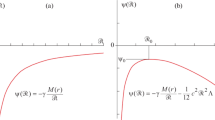Abstract
We consider a method for obtaining equations of the Hamiltonian dynamics for system of interacting massive charged particles using the general relativistic Einstein–Hilbert action. In the general relativistic case, Vlasov-type equations are derived in the nonrelativistic and weakly relativistic limits. Expressions are proposed for corrections to the Poisson equation, which can contribute to the effective action of dark matter and dark energy. In this case, an efficient approach to synchronizing the proper times of different particles of a many-particle system is proposed. Based on the obtained expressions for the action, we analyze the possibility of a composite structure of the cosmological term in the Einstein equations. Reduced Euler equations leading to the Milne–McCrea cosmological model are derived using a hydrodynamic substitution and are solved in the self-similar class.
Similar content being viewed by others
References
W. Pauli, Theory of Relativity, Dover, New York (1981).
V. A. Fock, Theory of Space, Time and Gravitation, Pergamon, New York–London (1959).
S. Weinberg, Gravitation and Cosmology. Principles and Applications of the General Theory of Relativity, John Wiley and Sons, New York–London–Sydney (1972).
L. D. Landau and E. M. Lifshitz, Course of Theoretical Physics, Vol. 2: The Classical Theory of Fields, Pergamon Press, Oxford–London (1962).
B. A. Dubrovin, A. T. Fomenko, and S. P. Novikov, Modern Geometry. Methods and Applications, Part I: The Geometry of Surfaces, Transformation Groups, and Fields (Graduate Texts in Mathematics, Vol. 93), Springer, New York (1984); Part II: The Geometry and Topology of Manifolds (Vol. 104, 1985); Part III: Introduction to Homology Theory (Vol. 124, 1990).
Y. Choquet-Bruhat, General Relativity and the Einstein Equations, Oxford Univ. Press, Oxford (2009).
C. Cercignani and G. M. Kremer, The Relativistic Boltzmann Equation: Theory and Applications (Progress in Mathematical Physics, Vol. 22), Birkhäuser, Basel (2002).
J. Ehlers, “General relativity and kinetic theory,” in: General Relativity and Cosmology (Proceedings of the International School of Physics “Enrico Fermi.” Course XLVII, Italian Physical Society, June 30 – July 12, 1969, R. K. Sachs, ed.), Academic Press, New York (1971), pp. 1–70.
L. Andersson and M. Korzyński, “Variational principle for the Einstein–Vlasov equations,” arXiv: 1910.12152.
R. W. Lindquist, “Relativistic transport theory,” Ann. Phys., 37, 487–518 (1966).
A. Vlasov, Statistical Distribution Functions, Nauka, Moscow (1966).
N. A. Chernikov, “Kinetic equation for a relativistic gas in an arbitrary gravitational field,” Sov. Phys. Dokl., 7, 397–399 (1962).
Yu. L. Klimontovich, “Relativistic transport equations for a plasma. I,” Sov. Phys. JETP, 10, 524–530 (1960).
Y. Choquet-Bruhat, Introduction to General Relativity, Black Holes, and Cosmology, Oxford Univ. Press, Oxford (2015).
Yu. G. Ignatyev, Relativistic Kinetic Theory of Nonequilibrium Processes in Gravitational Fields, Foliant, Kazan (2010).
V. V. Vedenyapin, V. I. Parenkina, and S. R. Svirshchevskii, “Derivation of the equations of electrodynamics and gravity from the principle of least action,” Comput. Math. Math. Phys., 62, 983–995 (2022).
V. V. Vedenyapin, V. I. Parenkina, A. G. Petrov, Zhang Haochen, “Vlasov–Einstein equation and Lagrange points,” (Preprints of Keldysh Institute of Applied Mathematics, Vol. 23), Keldysh Institute of Applied Mathematics (2022).
V. Vedenyapin, N. Fimin, and V. Chechetkin, “Derivation of Vlasov–Maxwell–Einstein equation and its connection with cosmological lambda-term [in Russian],” Bulletin MSRU. Series: Physics and Mathematics, 2, 24–48 (2019).
V. V. Vedenyapin, “Vlasov–Maxwell–Einstein Equation,” (Keldysh Institute of Applied Mathematics, Vol. 188), Keldysh Institute of Applied Mathematics (2018).
V. V. Vedenyapin and M. A. Negmatov, “Derivation and classification of Vlasov-type and magnetohydrodynamics equations: Lagrange identity and Godunov’s form,” Theoret. and Math. Phys., 170, 394–405 (2012).
V. V. Vedenyapin, M. A. Negmatov, and N. N. Fimin, “Vlasov-type and Liouville-type equations, their microscopic, energetic and hydrodynamical consequences,” Izv. Math., 81, 505–541 (2017).
V. V. Vedenyapin and M. A. Negmatov, “On derivation and classification of Vlasov type equations and equations of magnetohydrodynamics. The Lagrange identity, the Godunov form, and critical mass,” (Proceedings of the Sixth International Conference on Differential and Functional-Differential Equations, Moscow, August 14–21, 2011, Part 3), Journal of Mathematical Sciences, 202, 769–782 (2014).
V. V. Vedenyapin and M. A. Negmatov, “On the topology of steady-state solutions of hydrodynamic and vortex consequences of the Vlasov equation and the Hamilton–Jacobi method,” Dokl. Ross. Akad. Nauk, 87, 240–244 (2013).
V. V. Vedenyapin, M. Yu. Voronina, and A. A. Russkov, “Derivation of the equations of electrodynamics and gravitation from the principle of least action,” Dokl. Phys., 65, 413–417 (2020).
G. Rein and A. D. Rendall, “Smooth static solutions of the spherically symmetric Vlasov–Einstein system,” Ann. Inst. H. Poincaré Phys. Théor., 59, 383–397 (1993).
T. Okabe, P. J. Morrison, J. E. Friedrichsen, and L. C. Shepley, “Hamiltonian dynamics of spatially-homogeneous Vlasov–Einstein systems,” Phys. Rev. D, 84, 024001, 11 pp. (2011).
H. E. Kandrup and P. J. Morrison, “Hamiltonian structure of the Vlasov–Einstein system and the problem of stability for spherical relativistic star clusters,” Ann. Phys., 225, 114–166 (1993).
V. V. Vedenyapin, N. N. Fimin, and V. M. Chechetkin, “The generalized Friedmann model as a self-similar solution of Vlasov–Poisson equations system,” Eur. Phys. J. Plus, 136, 670, 11 pp. (2021).
V. Vedenyapin, N. Fimin, and V. Chechetkin, “The system of Vlasov–Maxwell–Einstein-type equations and its nonrelativistic and weak relativistic limits,” Internat. J. Modern Phys. D, 29, 2050006, 23 pp. (2020).
Funding
This work was supported by ongoing institutional funding. No additional grants to carry out or direct this particular research were obtained.
Author information
Authors and Affiliations
Corresponding author
Ethics declarations
The authors of this work declare that they have no conflicts of interest.
Additional information
Translated from Teoreticheskaya i Matematicheskaya Fizika, 2024, Vol. 218, pp. 258–279 https://doi.org/10.4213/tmf10551.
Publisher’s note. Pleiades Publishing remains neutral with regard to jurisdictional claims in published maps and institutional affiliations.
Rights and permissions
About this article
Cite this article
Vedenyapin, V.V., Fimin, N.N. & Chechetkin, M. Vlasov–Maxwell–Einstein-type equations and their consequences. Applications to astrophysical problems. Theor Math Phys 218, 222–240 (2024). https://doi.org/10.1134/S0040577924020041
Received:
Revised:
Accepted:
Published:
Issue Date:
DOI: https://doi.org/10.1134/S0040577924020041



